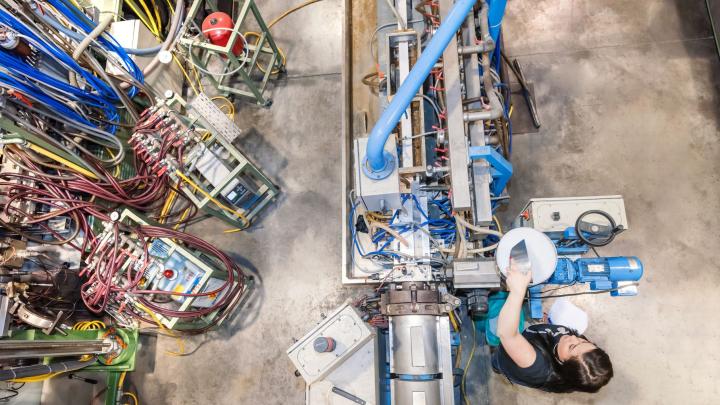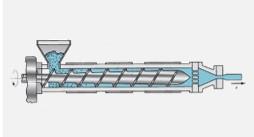
Extrusion process
Injextru Plastics has more than 40 extrusion lines and a wide array of machinery. That means we can extrude a vast range of technical plastic profiles, from small (a few millimetres) and light (a few grams) to large (550mm) and heavy (5.5kg).
As a custom plastic profile specialist, all those different machines enable us to fulfil every demand. With that in mind, we can extrude most thermoplastics on the market.
Standard extrusion line
This is a reproduction of a standard extrusion line. The steps below are followed to extrude a profile.
The extruder melts the plastic and forces it through the die. Here, we make a distinction between a main extruder and a co-extruder.
What is extrusion?
Extrusion is the process of shaping a heated material by forcing it through a die. The plastic is driven forward by a screw. The granulate is melted in the process. A standard screw is composed as follows:
- Feed zone: here heat is introduced from outside.
- Melting zone: here the material is pressed together, which causes it to melt, reducing the volume and increasing the density. This is offset by reducing the screw depth.
- Metering zone: here the melted material is mixed to create a homogeneous substance.

This substance is then forced through the die. The die is cast in such a way that the material takes on the required form as it is forced through at a constant speed. The die comprises various pieces:
- Adapter: connects the machine and the die.
- Rear piece: the extension of the adaptor.
- Die plate: depending on the type of profile, there may be several die plates.
The calibration unit cools down the profile as quickly as possible in its final form. Most of this is achieved by cooling the calibration parts with water. A vacuum finishes the job.
The calibration unit is followed by the puller. In plastic extrusion, on exiting the die the profile is pulled through the calibration unit. Depending on the profile, the belt pullers have different dimensions and shapes.
Our lines can accommodate multiple in-line postprocessing steps. They include printing, rolling, punching, drilling, milling, inserting filaments and applying foil or tape. Read more about special processing.
Lastly, the profiles are cut to length. We can do this in various ways:
- Sawing: always possible
- Cutting: with guillotine or cutter







